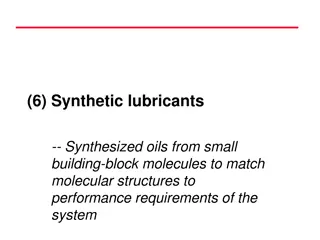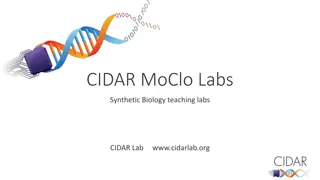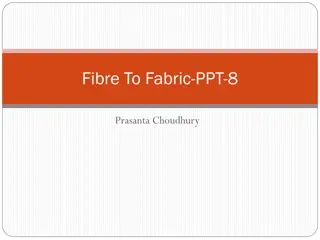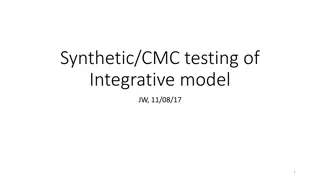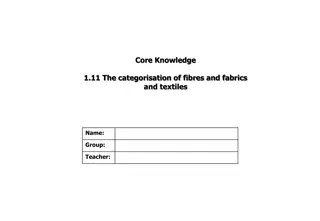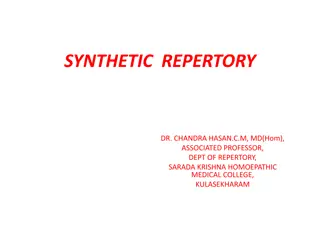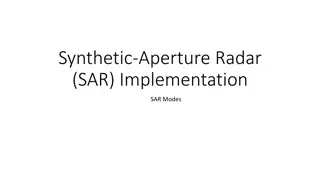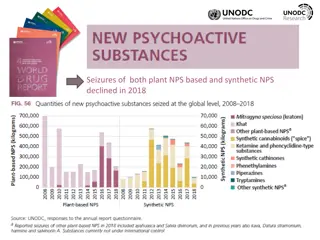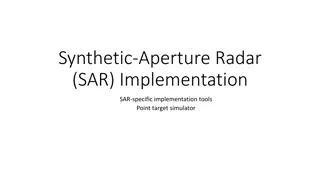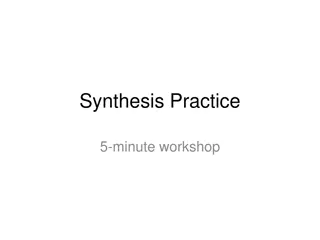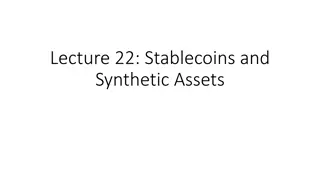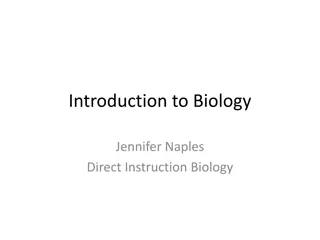Exploring Predictable Biodesign in Synthetic Biology
This content delves into the world of predictable biodesign and genetic composition in the context of synthetic biology. It highlights activities focusing on genetic device assembly, molecular techniques, and engineering principles to better understand and manipulate living systems. Through engaging approaches like color transformation in E. coli, genetic device output prediction, and modeling in circuit design, students and teachers are introduced to the fascinating realm of molecular genetics and bioengineering principles.
Uploaded on Jul 08, 2024 | 0 Views
Download Presentation

Please find below an Image/Link to download the presentation.
The content on the website is provided AS IS for your information and personal use only. It may not be sold, licensed, or shared on other websites without obtaining consent from the author. Download presentation by click this link. If you encounter any issues during the download, it is possible that the publisher has removed the file from their server.
E N D
Presentation Transcript
iTune Device This activity focuses on predictable biodesign and the composition of genetic parts, such as promoters and ribosome binding sites, to better understand how assembly influences the output of a genetic device. BioBuilder.org
Synthetic Biology Synthetic Biology uses genetic engineering techniques to construct synthetic living systems The synthetic biology approach familiarizes teachers and students with molecular biology genetic engineering microbiology methods ALL IN AN ENGINEERING SETTING iTune Device | BioBuilder.org
Synthetic Biology: Engineering Principles These principles and technologies extend the teaching of molecular techniques into real world, authentic applications iTune Device | BioBuilder.org
Design Build Test iTune Device | BioBuilder.org
What A Colorful World Examines the role of the cellular chassis in system performance. Students transform different strains of E. coli with DNA that turns the cells several bright colors. Students then observe how different the color intensity can be from strain to strain, despite being encoded by the same DNA sequence. iTUNE Device Examines the role of parts, such as promoters and ribosome binding sites, in predicting the output of a genetic device. The students measure -galactosidase enzymatic activity as the device s output, thereby looking through the lens of molecular genetics to predict and then evaluate a device s behavior. Picture This Three activities to explore the role of modeling in circuit design. These activities include a downloadable program to computationally vary the parameters of a genetic circuit, an exercise to mimic a genetic circuit with electronic parts, and an opportunity to send a stencil that will be turned into a bacterial photograph. Eau That Smell Compares two alternative genetic designs. Both programs should make the cells smell like ripe bananas as the cells grow. Golden Bread Explores the science, engineering and bioethics of a yeast that s genetically modified to make a vitamin-enriched food. Lab activities include PCR, yeast transformation, codon shuffling and statistical analysis of data iTune Device | BioBuilder.org
Predictable Design What would a company like Boeing or Airbus think if a new wing shape made the plane fly in unexpected ways? Designing and building in the face of such uncertainty would create huge expense and potentially put lives in danger. If an engineer modifies the standard tail of an airplane (left), then the novel design (right) must not introduce unintended behaviors that affect how the airplane can fly or land safely. iTune Device | BioBuilder.org
Predictable Design To predictably design new systems, engineers rely on .modular components that can be functionally assembled in a variety of ways, customizing combinations according to an individual s needs. When the modular components are physically connected, the parts must function as expected. Significant differences between predicted and observed behavior are unacceptable. iTune Device | BioBuilder.org
Predictable Design At this point in the field of synthetic biology, biological engineers are still working toward such functional assembly of genetic parts. Researchers have characterized many cellular behaviors at the molecular level. In many cases it s possible to catalog the genetic elements necessary and sufficient to carry out a biological function. Yet, combining these genetic components in new ways often generates unexpected results. iTune Device | BioBuilder.org
Predictable Design Modularity Insulation Measurement To improve the functional assembly of biological parts, synthetic biologists have focused on the .modularity , .insulation , and .measurement of genetic parts. These principles are more traditionally applied to the engineering of nonliving systems, but here they are tested in the context of an enzyme-producing genetic device. BioBuilder s iTune Device tests a variety of genetic circuits in cells, in order to compare their expected and their measured behaviors. iTune Device | BioBuilder.org
Modularity, Insulation, Measurement Modularity Modularity refers to the idea that engineers can design and generate systems by combining functional units, or modules. To understand the advantages gained from modularity, consider the way music distribution has changed. For much of the 20th century, the album was the standard unit for the music industry and its artists. Single songs were available but were significantly more costly, so even if people only liked a few of the songs on an album, they generally bought the album. iTune Device | BioBuilder.org
Modularity, Insulation, Measurement Once music was digitized, it became possible to download it. Suddenly, buying the physical album was no longer necessary, and individual songs from any digital album could easily be unbundled. The songs became independent modules that listeners could mix and match as desired and needed. iTune Device | BioBuilder.org
Modularity, Insulation, Measurement Modularity is sensible to apply to biology as well, because we can attribute discrete functions to particular snippets of DNA and protein domains. This notion of genetic parts is fundamental to synthetic biology. iTune Device | BioBuilder.org
Modularity, Insulation, Measurement Insulation Insulation keeps modules from interacting from with one another in undesirable ways. This is a familiar feature of many engineered objects. For example, the operation of a car s stereo doesn t affect the operation of the driver s steering wheel. If it did, then twisting the knob on the radio might also turn the steering wheel -- presenting a real challenge for safe operation of the car. iTune Device | BioBuilder.org
Modularity, Insulation, Measurement Unlike a car, the cell is a fluid environment. The molecules, proteins, and cellular structures are constantly mixing. How is it possible to insulate their behaviors when they encounter new partners and neighbors all the time? iTune Device | BioBuilder.org
Modularity, Insulation, Measurement One of the major challenges in synthetic biology is to rationally design living systems with component parts that do not interfere with one another or with the basic cellular machinery needed to maintain growth and life. iTune Device | BioBuilder.org
Modularity, Insulation, Measurement Measurement Whether it s the number of cards in a deck, the horsepower in a car engine or the score in a football game, measurements tell us about the state of the items, and their behaviors, relationships, or characteristics. Measurements allow us to compare items with one another, using an agreed upon unit for measuring them. iTune Device | BioBuilder.org
Modularity, Insulation, Measurement Units might be taken for granted in something like sports, where teams get a standard number of points for each basket or goal. But some measurements are less clear and in some cases, like the English vs the Metric system, the units are not even agreed upon. iTune Device | BioBuilder.org
Modularity, Insulation, Measurement You might think it would be easy to measure the height of a horse, for example. From hoof to wither (~shoulder) could be 67 inches or maybe 1.7 meters. In fact, such a horse would be 16.3 hands high, since King Henry VIII standardized a hand (his hand) to be 4 inches and the units after the decimal to reflect additional inches. iTune Device | BioBuilder.org
Modularity, Insulation, Measurement One of the major challenges in synthetic biology is to rationally design living systems with component parts that do not interfere with one another or with the basic cellular machinery needed to maintain growth and life. iTune Device | BioBuilder.org
Modularity, Insulation, Measurement The power of measurements Scientists use measurement as a powerful tool for discovery. Mendel, for instance, uncovered the rules for inheritance by counting offspring with particular traits and looking for patterns. Engineers use measurement not only to describe systems but also to control, assemble, and improve the objects being measured. Some engineering measurements are described in the table on the right iTune Device | BioBuilder.org
Modularity, Insulation, Measurement By measuring the actual performance of synthetic living systems and comparing the measurements to what was predicted, synthetic biologists can assess their designs and move closer to correctly anticipating the success or failure of future designs. iTune Device | BioBuilder.org
Introduction to Gene Regulation The mantra DNA makes RNA makes protein is shorthand for the knowledge that RNA sequences are transcribed from DNA sequences, and that those RNA sequences can be translated into the proteins that carry out many of the key jobs in a cell. Transcription and translation have been extensively studied so many of the core components that control these processes are known. iTune Device | BioBuilder.org
Introduction to Gene Regulation For example a .promoter is the term for a DNA sequence where RNA polymerase binds and initiates transcription. Similarly, the sequence where translation initiates in bacteria is a site known as the .ribosome binding site (RBS) , defined as the DNA sequence that allows ribosomes to begin protein synthesis from the RNA copy. Additionally, an .open reading frame , abbreviated .ORF , represents a DNA sequence that encodes a protein. It is often illustrated as an arrow or a box. The direction of the arrows indicate the direction on the DNA strands in which the promoter or ORF are read. iTune Device | BioBuilder.org
Introduction to Gene Regulation The lac operon In the 1960s, Dr. Francois Jacob and Dr. Jacques Monod identified foundational principles of gene regulation through their studies of lactose transport and metabolism in bacteria. The genes for lactose metabolism are clustered in the lac operon. The lac operon consists of a single promoter (pLac, green arrow) controlling three downstream RBS ORF pairs (green semicircles and blue arrows, respectively). A single mRNA is transcribed from the lac operon s promoter, giving rise to the multiple protein products needed for lactose metabolism and transport. Translation of each product can occur from the single mRNA thanks to the RBSs that are associated with each ORF. iTune Device | BioBuilder.org
Introduction to Gene Regulation Bacteria conserve energy by transcribing the lac operon genes only when glucose is absent. When glucose is present, a transcriptional repressor protein encoded by the LacI gene turns off transcription of the lac operon. When lactose is present and glucose is absent, the lac repressor protein switches behaviors and allows for transcription of the operon so lactose can be transported into the cell and metabolized. iTune Device | BioBuilder.org
Introduction to Gene Regulation In this lab, the cells will be grown in the presence of IPTG, which will artificially remove the lac repressor protein from the Plac promoter. In this way we can be sure that measurements reflect the fully de-repressed promoter. iTune Device | BioBuilder.org
Introduction to Gene Regulation The key protein for lactose metabolism is an enzyme called -galactosidase, often abbreviated -gal, and it is encoded by the ORF called lacZ. The -gal enzyme cleaves lactose into glucose and galactose, which can be used by the cell to power its other functions. Researchers found that -gal reacts with a variety of molecules similar to lactose, including synthetic analogs such as ONPG, which you will use in the iTune Device lab. iTune Device | BioBuilder.org
Introduction to Gene Regulation In this lab, you will react the cells with ONPG, which will turn the solution yellow according to how much -gal the cells are making. More yellow more -gal! iTune Device | BioBuilder.org
Introduction to Gene Regulation The lac operon While the other ORFs in the lac operon, lacY and lacA, are important for lactose transport and metabolism in wild-type bacteria, they are dispensable for BioBuilder s iTune Device experiment. Your measurements of lacZ expression in this experiment will be dependent only on the Plac promoter and ribosome binding site. iTune Device | BioBuilder.org
BIOBUILDERS iTUNE DEVICE ACTIVITY BioBuilder s iTune Device activity emphasizes the test phase of the design-build-test cycle. Standard biological parts were combined to build several variants of an enzyme-generating genetic circuit. The circuits have small differences in their DNA sequences, which are expected to change the amount of enzyme the cells produce. Test What predictions can be made about the output for the genetic circuits? iTune Device | BioBuilder.org
BIOBUILDERS iTUNE DEVICE ACTIVITY It seems reasonable that a strong promoter would give rise to more enzyme activity than a weak promoter. But can we predict just how much more? Examining the DNA sequences of the parts gives some clues to the activity of the parts because the most commonly found sequence for each part is called the . consensus sequence. . Changes from the consensus will affect the efficiency of transcription for the promoter parts and of translation for the RBS parts -- though it s hard to know by how much. iTune Device | BioBuilder.org
BIOBUILDERS iTUNE DEVICE ACTIVITY Even more difficult to anticipate is how modular and how insulated the parts are from one another. Perhaps a medium promoter and a strong RBS will give greater activity than a strong promoter and a medium RBS. Luckily, the output of each genetic circuit can be measured with an enzyme assay, allowing predicted and actual behaviors to be compared quantitatively. iTune Device | BioBuilder.org
BIOBUILDERS iTUNE DEVICE ACTIVITY MEASURING ENZYME ACTIVITY The assay for -gal activity is carried out on cells that have been grown in LB with Ampicillin and IPTG. The Ampicillin selects for the plasmids carrying the genetic circuits. The IPTG insures that the lac repressor protein is not binding to the promoter region of the circuits. iTune Device | BioBuilder.org
BIOBUILDERS iTUNE DEVICE ACTIVITY Once the cells are grown, their density is measured using a spectrophotometer set to 600 nm. The spectrophotometer measures the amount of light scattered by the cells. More cells lead to more scattering and a higher absorbance. If no spectrophotometer is available, then it is possible to use MacFarland standards, made with barium chloride and sulfuric acid. The cells are then lysed with detergent to release the -gal enzyme from the cell , reacted with ONPG for a measured amount of time, and then the reactions are stopped by changing the pH of the solutions which inactivates the enzyme. The amount of yellow color in the reactions is measured with the spectrophotometer set to 420 nm. If no spectrophotometer is available, then it is possible to use yellow paint samples, as described on the BioBuilder website. iTune Device | BioBuilder.org
BIOBUILDERS iTUNE DEVICE ACTIVITY Reference Measurements To compare data collected by different laboratory groups, you will use a reference promoter:RBS:lacZ sequence. This reference is known to generate some intermediate amount of enzyme, so you can use it to calibrate all the other measurements you make. The reaction run without any cells can serve as one negative control as well as the blank for the spectrophotometer. iTune Device | BioBuilder.org
Good Luck! BioBuilder.org




